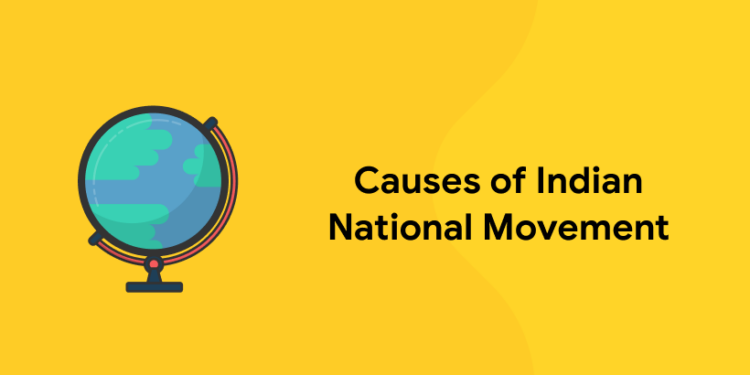Table of Contents
The Indian National Movement was an organized mass movement concerned with the interests of the people of India and affected by both internal and external factors. It led to the formation of the Indian National Congress in 1885 and several revolts broke out across the country. The Indian National Movement began in the later half of the nineteenth century.
The History of our freedom movement is not a single comparable story. It has several multiple strands that interluced and influence each other and spread out into the portrait of a struggle of our people for Independence. The efforts of the group of political leaders led to legal and constitutional changes. The deterioration of the revolutionaries led to heroic actions and an uncompromising struggle. The mass movement had happened to focus by Mahatma Gandhi led to widespread response from all sections of the population. Each movement fed into the other and enhanced each other and in the end led to freedom for our country.
Around 75 years ago, on the historic date of 15th August 1947, India became independent from British rulers. It was at the highest peak of several movements and struggles that were wide spread throughout the time of British rule. This independence was achieved through the efforts of many revolutionary freedom fighters, who took the lead in organizing the freedom fight which led to India’s independence. Although they were of varied ideologies ranging from moderates to extremists, their contribution to India’s freedom struggle has been commemorates in the thoughts of every Indian.
Most Famous Freedom Fighters Of Our Country
-
Mahatma Gandhi
Mohandas Karam Chand Gandhi also known as “Father Of Nation” because of his good deeds and lot of struggles for the freedom of our country. He was born on October 2, 1869. At the age of 13 he was married to Kasturba after that he went to South Africa for the practice of law. After witnessing racial discrimination against some Indians he was inspired to fight for human rights. After seeing the state of India under English rule, Gandhi became an impassionate supporter of the independence movement. He marched “DandiKuch” on his naked feet to protest salt taxes and led several nonviolent anti-British movements in his pursuit for independence.
-
Jawaharlal Nehru
Jawaharlal Nehru was born in 1889, the only son of Motilal Nehru and Swarup Rani. Nehru began his career as a lawyer before becoming one of the famous freedom fighters and politicians. He was influenced my Mahatma Gandhis effort to free India from Britishers. He became involved in the freedom struggle, rising to the position of President of the Indian National Congress before becoming India’s first Prime Minister after independence. He was nicknamed “Chacha Nehru” because of his love and respect towards children, and his birthday is observed as Children’s Day.
Attempt Free GK Mock Test ! Download ENTRI App !
-
Sardar Vallabhbhai Patel
Vallabhbhai Patel, who was born in 1875 and earned the title of ‘Sardar’ after his heroic contribution in the Bardoli Satyagrah, was most brave and epic from a young age. He earned the nickname “the iron man of India” as a result of his valiant efforts. Sardar Patel began his career as a lawyer, but he left the profession to fight for India’s independence from British rule. Following India’s independence, he became the country’s Deputy Prime Minister and dedicated himself to uniting the country’s princely states.
-
Tantia Tope
Ramachandra Pandurang Tope also known as Tantia Tope was born in 1814, and become as one of the famous freedom fighters in 1857. He led a group of soldiers to fight the British and end their dominance. Tantia Tope defeated the Indian troops of the East India Company at Kanpur in May 1857. He led the Indians in the 1857 Rebellion and was noted for his guerilla tactics, which terrified the British. General Windham was forced to leave the city of Gwalior by him .Even with no formal military training, he was one of the effective fighters. He was hanged to death on April 18, 1859 by the British rulers.
-
Lal Bahadur Shastri
Lal Bahadur Shastri was born in the state of Uttar Pradesh in 1904. After completing his studies at Kashi Vidyapeeth, hegot the title as “Shastri”. He was one of the famous freedom fighters who took part in Mahatma Gandhi’s Quit India, Civil Disobedience, and Salt Satyagrah movements. He also spent a remarkable amount of time in prison. Following independence, he served as Home Minister before becoming Prime Minister of India in 1964. Shastri was known for his honesty and humility throughout his life. He was awarded the Bharat Ratna after death, and a memorial “Vijay Ghat” was built for him in Delhi. There are several educational institutions that bears his name.
-
Subhas Chandra Bose
Subhas Chandra Bose also kown as Netaji, was born in Orissa in 1897. The title name “Netaji” was first applied to Bose in Germany in early 1942— by the Indian soldiers of the Indische Legion and by the German and Indian officials in the Special Bureau for India in Berlin. He raised the first Indian National Army (INA), Azad Hind Fauj in 1943 and started an armed coup and inspired thousands of Indian youths to join the struggle for independence from the British colonial rule. His famous slogans are ‘tum mujhe khoon do, main tumhe aazadi dunga’, ‘Jai Hind’, and ‘Delhi Chalo’.
-
Rani Lakshmi Bai
The Queen of Jhansi, Rani Lakshmi Bai, was born in 1828. She was an epitome of courage and bravery. She was born in a Maratha family and she played an important role in the struggle for Independence against the Britishers in 1857. Despite the fact that she was a woman, she symbolize bravery and a fearless attitude, inspiring thousands of women to join the fight for freedom. When a British force led by Sir Hugh Rose attempted to invade Jhansi in 1858, she bravely defended her palace.
-
Bhagat Singh
He was born in Punjab to a Sikh family of freedom fighters in 1907. He was a hero of the early 20th-century Indian independence movement. He was a vocal critic of British rule in India and was involved in two high-profile attacks on British authorities—one on a local police chief and the other on the Central Legislative Assembly in Delhi. As a result, he was a natural patriot who joined the non-cooperation movement in 1921. To instill patriotism in Punjab’s youth, he founded the “Naujawan Bharat Sabha.” He was changed by the Chauri-Chaura Massacre, and his fight for freedom became more extreme as a result.
-
Dadhabhai Naoroji
Dadhabhai Naoroji, who was born in 1825 , also known as the “Grand Old Man of India” and “Unofficial Ambassador of India”, was an Indian political leader, merchant, scholar and writer is credited with founding the Indian National Congress. He’s also one of the most well-known members of the nonviolent independent movement. In one of his books, he argued that British colonialism in India was equivalent to stealing the country’s wealth.
-
Lala Lajpat Rai
Lala Lajpat Rai, also known as Punjab Kesari, was born in Punjab in 1865.He was an Indian author, freedom fighter, and politician. He played a pivotal role in the Indian Independence movement. He was one of the Indian National Congress’s extremist members and was a member of the Lal-Bal-Pal trio. He rose to prominence after leading the Non-Cooperation Movement and the Punjab Protest against the Jallianwala Bagh incident in 1920. He was killed by Britishers in a brutal Lathi charge during a Simon Commission protest in 1928.
Let us honor all the freedom fighters of our nation and be proud of them.
Grab The Latest GK Study Materials – Register Here !
Indian Freedom Struggle
Indian freedom struggle was lasted from 1857 to 1947. For the sake of freedom, our great freedom fighters sacrificed their lives by laughing without worrying about their lives. If, at that time, the countrymen had not raised their voice against the British, then perhaps even today the country would have been slavery to the British. The Indian National movement was a series of historic events with the ultimate aim of ending British rule in India. The Indian National Movement was an organized mass movement concerned with the interests of the people of India and affected by both internal and external factors. It led to the formation of the Indian National Congress in 1885 and several revolts broke out across the country.
Initially, the British came to India in the year 1600 with the objective of doing business under the name of East India Company. Under the guise of silk, tea, and the cotton trade, they started spreading chaos in India and gradually made the country their slave and after that, the British took the rule of the entire country into their hands and started persecuting the Indians. Due to this the demand for freedom started arising in the country. The first freedom struggle was started by an Indian soldier Mangal Pandey. This struggle was not accidental but a result of the discontent of the entire century. A great plan was made and implemented for this. The first challenge against the British rule was the Revolt Of 1857.
Attempt Free GK Mock Test ! Download ENTRI App !
Revolt Of 1857
It began with the revolt of military personnel in Meerut soon spread throughout India and posed a serious challenge to British rule. Along with soldiers, common citizens, large princely states of the country also participated in this struggle. Rani Lakshmi Bai of Jhansi fought a glorious war against the British and led her forces. This revolution was controlled by the British rule within 1 year which started in Meerut on 10 May 1857 and ended in Gwalior on 20 June 1858.
Indian Freedom Struggle During 1857-1947
The Civil Disobedience Movement was also one of these major movements that were started against the British monopoly on salt. It was started in 1930 under the leadership of Mahatma Gandhi, which started with Gandhiji’s famous Dandi March. Meanwhile, Bhagat Singh is hanged for his country at the age of just 23.The death of Lala Lajpat Rai encouraged him to fight against the British.
Bhagat Singh take revenge this by killing Officer John Sanders and he was also prosecuted for the Lahore Conspiracy. And on the night of 23 March 1931, Bhagat Singh was hanged along with Sukhdev and Rajguru. After this, the Quit India Movement started in 1942.This movement showed a ray of hope to the people of India but despite difficult struggles, this movement was not so successful. But it shiver the roots of British rule. Similarly, many freedom fighters like Subhash Chandra Bose, Bal Gangadhar Tilak, Chandrashekhar Azad, Sardar Vallabhbhai Patel, Pandit Jawaharlal Nehru, etc. struggled a lot to make the country independent. Soon the British rulers signed an agreement and decided to leave India and India got independence on 15 August 1947.
Causes Of Indian National Movement
The major causes behind the rise of the the Indian National movement were colonial policies and the reaction to those policies.
There are many reasons for the rise of the National Movement of India. Some of them are following:
-
Common British Administration
-
Education
-
Economic Policies
-
Infrastructure
-
Growth of Press
-
Socio-Religious Movement in India
-
Ilbert Bill Controversy
-
Legacy of the 1857 revolt
-
The policies of Lord Lytton
-
Vernacular Languages
-
Changing Social Order
The mass movement failed to achieve independence for India as It was called off many a times before it naturally ended. But Indians were triggered by figures like Mahatma Gandhi with his non-violent philosophy. This created pressure on the British occupation. While in the later years, a huge amount was placed on the British tax payers as per the 1935 Government of India act because of Raj economic factors like exchanging trade fortunes between Britain and India and the cost of fielding the Indian armed forces abroad. This further had implication on the British government as the unity of Indians was totally against them. Nationalist Movements in India contributed to the independence in 1947.














